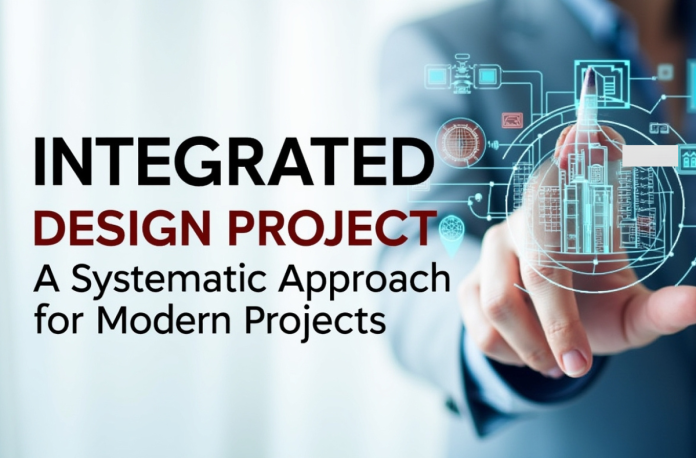When building or designing something complex, the old way of working in separate departments always leads to problems, delays, and surprise costs. You finish the plans, and suddenly the engineers find a major conflict. This painful fragmentation is exactly what the Integrated Design Project (IDP) was created to fix. IDP is a powerful method of bringing the entire project team together. This is the whole-systems approach in action, optimizing the outcome by looking at how all parts connect.
Teams using an Integrated Project Delivery method deliver higher quality facilities faster and with better financial control. Ready to find out what an integrated design project is and why this shift is essential for modern success? We will break down the methodology, compare it to traditional approaches, and look at practical integrated design project example ideas.
Table of Contents
- Why Traditional Projects Often Fail?
- What Is an Integrated Design Project and How Does It Work?
- The Three Core Stages of the Design Process
- Integrated Project Delivery vs Traditional Project Delivery
- Measuring Success of an Integrated Design Project
- The Integrated Design Mindset in Education and Careers
- Conclusion
- FAQs
Why Traditional Projects Often Fail?
To truly understand the value of an integrated design project, we must first look at the old way of doing things. The traditional model, usually called Design-Bid-Build, creates friction by design.
The Problem with Working in Separate Departments
In the traditional project delivery model, work moves along a single, sequential path. The architect finishes the design first. Then, those completed plans are handed off to the builder. This linear process means everyone works alone, or in a “silo”.
The biggest issue? Conflicts are discovered too late, often during actual construction. If the ventilation system won’t fit the wall structure, it will cause expensive rework. The original designer is often long gone, forcing teams into a culture of pointing fingers. Everyone focuses on minimizing their own financial liability instead of solving the problem for the project’s overall benefit. This approach cannot meet the complex demands of modern, sustainable buildings.
How Whole-Systems Thinking Works Like Nature
The traditional model treats a building or product like a collection of separate pieces. The whole-systems approach (WSA) changes this mindset completely. WSA sees the project as a single living entity where every part depends on the others. It recognizes the complex patterns and connections linking all the different systems together.
Think about designing a complex system, like the human body. If the structural designer (the architect) designs the framework without speaking to the systems designers (the engineers), the internal organs won’t fit or function well.
WSA ensures all specialists meet from day one. The main goal is to optimize the whole system, not just one specific component. This means solving the correct problems before engineering begins, which saves time, resources, and waste throughout the entire life cycle.
What Is an Integrated Design Project and How Does It Work?
If the whole-systems approach is the philosophy, the integrated design project is the detailed, step-by-step process used to make that philosophy real. It requires collaboration and intense planning early in the timeline.
Bringing the Whole Team Together Early
Integrated Design Project actively breaks down those traditional barriers. It requires all key participants, including the client, architect, engineers, construction manager, and even those who will operate the finished building, to join the team right from the project’s start. This is the essence of Integrated Design Project and why it succeeds.
The team first meets in a structured workshop, often called a charrette, to hash out the goals of clients and create a shared vision. This high level of early, focused planning is vital for any big project, especially those aiming for high-performance results.
Why is this early involvement crucial? Because the cost to change something increases dramatically the later you find the problem. By aligning goals and reviewing constructability right away, the team minimizes costly rework. This creates a stronger foundation for the entire integrated project design.

The Three Core Stages of the Design Process
The process follows a logical flow to move from big-picture thinking to practical results:
- Discovery: The team fully maps out the project’s background, existing conditions, and all stakeholder needs. This creates a solid baseline.
- Dream: This is the aspirational stage. The team temporarily sets aside practical concerns to ask: “What is the ideal outcome if we had absolutely zero limits?” This sets the project vision, aiming to maximize value and minimize waste.
- Design: Based on that “Dream” and the “Discovery” phase, the team starts structuring the actual design. They figure out what is practical while still staying true to the ambitious goals set earlier. This guarantees the final design solution is both practical and achievable.
To execute the Design stage successfully, the team concentrates on analyzing the core work process against several key criteria. This deep analysis acts as the visual flow the team follows:
- Cycle Time Analysis: Finding the fastest path from start to finish without interruptions.
- Quality Assessment: Designing features that eliminate or reduce potential quality problems.
- Cost Management: Spotting significant costs and finding ways to cut them while making quality better.
- Waste Elimination: Removing unnecessary steps or delays to make the process smoother.
Using Integrated Design Project for High-Performance Green Building Standards
Integrated Design Project is especially vital in the world of high-performance and sustainable construction. The Integrated Design Project method is the proven route for creating efficient, eco-friendly spaces.
The US Green Building Council (USGBC) formalized this by including the Integrative Process (IP) credit in its LEED v4 (Leadership in Energy and Environmental Design) system. LEED, a global benchmark, requires more than just meeting a checklist.
The IP credit specifically demands early, focused analysis of key systems, like energy and water, to find opportunities where they can work together perfectly to save resources. Trying to manage a complex LEED project using conventional methods often requires costly modifications late in the design.
The approach avoids this by making sustainability the main driver from the start. This approach maximizes efficiency and minimizes long-term lifecycle costs.
Integrated Project Delivery vs Traditional Project Delivery
When discussing Integrated Design Project, you will hear the term Integrated Project Delivery (IPD). IPD is the official legal and contractual method that puts the principles of the integrated project design into formal practice.
Understanding the Power of a Shared Contract
The most critical difference between IPD and other methods is the contract. In true IPD, the three core parties, the Owner, the Architect, and the Constructor, are all legally joined under a single, Multi-Party Agreement (MPA).
This single legal document outlines the role, rights, obligations, and liability for all primary participants. This is the key difference when considering integrated project delivery vs design-build. While Design-Build (DB) contracts the owner to one firm that handles both design and construction, IPD goes further. IPD requires the primary players to sign the same contract as the owner.
This legal link turns everyone into a true partner. Success and risk are shared. This financial alignment forces everyone to prioritize the project’s overall success rather than competing to protect their individual budget. This is what the integrated design and project delivery model is truly about.

Using Lean Principles to Reduce Waste
IPD achieves superior performance when it includes Lean principles. Lean construction focuses on systematically minimizing waste in time, materials, and effort to maximize value.
The open communication and shared problem-solving inherent in the integrated project delivery system allow Lean teams to spot potential issues proactively. This significantly cuts down on significant areas of waste. A straightforward way to measure this efficiency is by reducing Requests for Information (RFIs).
Studies show IPD projects generate significantly fewer RFIs (those formal questions raised during construction), proving that the thorough Integrated Design Project process avoids major confusion and costly rework later.
Here is a comparison of how IPD differs from other project methods:
| Factor | Traditional (Design-Bid-Build) | Design-Build (DB) | Integrated Project Delivery (IPD) |
|---|---|---|---|
| Goal Alignment | Individual goals (Designer vs. Builder) | Moderate alignment | Unified, jointly developed goals; success is shared |
| Risk Allocation | High risk for Owner; adversarial teams | Risk is mainly with the single DB firm | Shared risk and reward among all key parties |
| Collaboration Level | Sequential; Low integration | Moderate; Single firm coordination | High; Multi-Party Agreement mandates deep teamwork |
| Design Optimization | Poor; Conflicts arise late | Good coordination | Continuous, Whole-Systems Optimization from Day 1 |
Measuring Success of an Integrated Design Project
Does all this complex collaboration pay off? Absolutely. Research confirms that the Integrated Design Project method is not just a theory; it delivers superior, measurable outcomes in practice.
Real Data on Why Integrated Design Delivers Better Outcomes
Detailed research comparing IPD projects to traditional projects consistently shows impressive results. IPD provides statistically significant improvements across 14 metrics, covering quality, schedule, environment, and finances.
The most powerful finding is that the Integrated Design Project consistently delivers higher quality facilities faster and without a major cost increase. This means the money invested in early design collaboration pays for itself by preventing expensive problems later on.
Projects using IPD generally experience less schedule growth and overall faster completion. This success is tracked using key performance indicators that ensure continuous monitoring and adjustment based on hard data from all project members.
A Real Integrated Design Project Example
The effectiveness of Integrated Design Project truly shines in high-performance building case studies. Take, for example, Canyon View High School. This project utilized a progressive thermal storage approach to significantly increase building efficiency.
To achieve this, the team built Phase Change Materials (PCM) right into the construction. This material choice required the architect (responsible for the building materials) and the engineer (responsible for thermal systems) to collaborate intensively from the very first phase. This seamless coordination resulted in a measured 3- to 4-degree Fahrenheit decrease in operative temperature in those rooms compared to similar non-integrated spaces.
This measurable result proves that when an integrated design project example is managed correctly, the systems work together perfectly to save energy and provide a high-quality environment.

The Integrated Design Mindset in Education and Careers
The central lesson of Integrated Design Project, which is seeing how systems connect, is a crucial skill for every student and professional today.
Integrated Design Project Ideas for Students
The principles of Integrated Design Project are so basic that they are now being included in school curricula. For example, the Central Board of Secondary Education (CBSE) now requires art-integrated project design assignments. This aims to blend core academic subjects with traditional Indian art forms.
Consider a project that combines Mathematics and Warli Art. Warli art, from Maharashtra, uses simple geometric shapes such as circles and triangles to depict social life. Students learn that art and math are linked, as complex forms are built from basic shapes arranged with mathematical precision. They explore how this ancient wisdom relates to modern concepts like the Golden Ratio (1:1.618).
For students at places like the National Institute of Fashion Technology (NIFT), this approach proves that design is never isolated; it is always linked to technology, engineering, and culture. This exercise teaches the core principle of interdependence, a key takeaway from this work.
The Human Factor in Making IPD Work
While contracts like the Multi-Party Agreement (MPA) set the legal framework, the actual success of an integrated project design depends entirely on the people. Even in student-integrated projects, challenges like communication issues, scheduling conflicts, and differences in opinion are common.
High-integration methods require exceptionally high levels of trust, mutual respect, and open communication to overcome these hurdles. When teams don’t trust each other, they fall back into old habits of competing interests, which ruins the shared financial goals.
To foster this culture, many IPD teams use co-location, sometimes called the “Big Room,” where key participants work in the same physical space. This daily interaction builds the strong working relationships needed for seamless problem-solving and ensures every integrated project delivery is executed efficiently.
Why Continuous Improvement Is Key
The integrated mindset is not a one-time process; it is a commitment to continuous refinement. The framework for integrated design and project delivery places a heavy emphasis on learning and getting better over time.
This means systematically gathering, analyzing, and sharing feedback throughout the project life cycle to refine practices. Teams must embrace a culture of learning and continuous improvement to get the full benefits of this integrated approach. This proactive feedback loop guarantees that all future work, whether writing an integrated design project report or building a skyscraper, benefits from every lesson learned.
Conclusion
The integrated design project, driven by the whole-systems approach, is the future of solving complex modern challenges. By replacing the outdated, fragmented delivery model, Integrated Design Project enforces early, deep collaboration among all key players. It uses a single legal structure to align financial risk and reward, which makes everyone focus on the overall success of the outcome.
The evidence is clear: this connection-first approach consistently delivers better quality, reduced waste, faster schedules, and superior environmental performance without incurring major additional costs. This methodology proves that the highest form of efficiency comes not from isolation, but from radical collaboration and a unified, collective purpose.
FAQs
Simple Integrated Design Project ideas focus on connections. Try designing a sustainable house where the roof water collection system feeds the garden (water and landscape integration), or an online tool where the user interface and back-end database are built simultaneously (software integration).
In Design-Build, a single firm usually assumes most of the risk. In Integrated Project Delivery, the core parties (Owner, Architect, Contractor) enter a Multi-Party Agreement, meaning they share both the risk and the financial reward.
No, the format changes based on the field. A technical course may require an Integrated Design Project report with detailed sections on scope, system architecture, interfaces, and testing approaches. A corporate report focuses more on strategy and performance.
Absolutely. The core concept of art-integrated project design is seeing the connection between creative vision and technical constraints. Professionals use this to ensure that the aesthetic goals of the architecture work perfectly with the engineering requirements for sustainability, cost, and function.
Institutions like NIFT emphasize this because modern careers demand professionals who can blend creative vision, technical knowledge, and management skills. IPD training prepares students for collaborative, real-world project scenarios.











